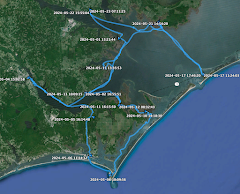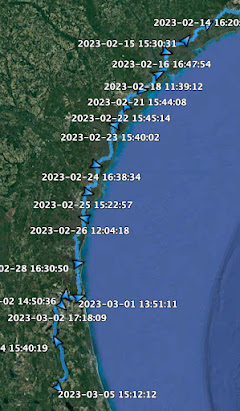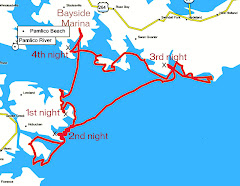
I got a note from Jim, who is looking over his set of plans for a Pathfinder, asking about the wooden masts I used on Spartina. The plans include the specs for aluminum masts but John Welsford was more than happy to point me in the right direction for using wood instead. You can see both the main and the mizzen, above, as I did some maintenance last spring. (Jim, I know you need no advice on how to make the masts - you are way ahead of me in that area - but I hope the numbers help).
I had hoped to build my masts and spars out of sitka spruce, the classic wood for that sort of thing. I went to my local woodshop, Yukon Lumber in Norfolk and asked for sitka spruce. After they got done laughing they said if they could find any sitka spruce I could not afford it. Douglas fir, they told me, was the way to go.
I made birdsmouth masts, hollow masts made out of eight staves with plugs in the top and bottom ends. Google birdsmouth mast and you'll find plenty of websites explaining how to do it. Some of the best articles were, of course, at Duckworks.

Above is the very end section of the main that was trimmed off before finishing the mast - it gives you a pretty good idea of the construction technique. The eight points on the mast were planed down giving me sixteen points. The sixteen points were planed down to give me 32 points. And those 32 points were sanded smooth to give me a fairly round mast.
On advice from the guys as Yukon Lumber I (I should say "we" -- my Dad came back for the mast building effort and was a full partner in the work) cut the wood "quarter sawn" which I think means cut and turned on its side to expose the grain. All that extra grain looks very nice I've got to say. For the main we used a 2 in x 8 inch x 20 foot piece of wood. We ripped it into 3/4 inch wide strakes and then cut those to a width of 1 and 1/16 inch. After notching (the birdsmouth shaped "v"), gluing, planing and sanding the main came out as planned at 3 and 1/4 inch diameter. It is mostly hollow, save for top couple of feet and the bottom portion from the the mast step to about 18 inches above the deck partner.
The specs I was give called for the mast to be tapered above the deck. That was beyond me, we left the mast at the same diameter from top to bottom. Without hardware it weighed 27 pounds.

And above is the mizzen (with a pretty good view of the quarter sawn grain). Strakes were 3/4 inch x 3/4 inch - it all came from one 1x8x16 piece of douglas fir. We had a hard time cutting the plug to fit inside at the top and bottom. Instead we just used pieces of hardwood dowel at either end. Finished diameter on the mizzen is 2 and 1/8 inches. The mizzen is designed to bend, I think "whippy" or something like that was the word used to describe it at some point. This lets the mizzen spill the wind when gusts kick up. Under 12 or 14 knots I snug the mizzen sheet in and let it be, the mast will bend and adjust to the wind.
When I started construction of Spartina I had thought the wooden masts would be one of the more difficult parts of the build. Instead it was one of the easier jobs. I practiced the skills as I first built the mizzen boom, gaff and main boom - they are all birdsmouth construction but with full length plugs to make them solid and stiff. Once we had the technique down it was easy.
steve










































7 comments:
Nicely done.
Trying to figure out how to do that made my head hurt, especially when it came to the taper. I was glad my masts are short enough to get by without it.
Glad you thought it was easy Steve.
My dad would've been all over that
(see http://lnsart.com/sultana_craftsmen_at_work.htm). Specifically Jim Wagner parceling shrouds with hemp.
I think of him often when I read your posts and I'm sure he would be fascinated as well.
I don't mean to give the impression that this is fine woodworking. It isn't. I'm not a boat builder or a wood worker but building Spartina was the only way I could get out on the water and do what I wanted to do. I tell people Spartina is a nice looking ten foot boat - stand ten feet away and she looks pretty nice. Get any closer and you'll see the flaws (the same applies to me). steve
Great post Steve! Tapering a hollow spar is easy. Just figure the minimum diameter stave length and clamp the stave to a flat board at that point back to the starting point of the taper (or tapers) and route the flat edge along that line. We use a shaper to cut the "vee" notch but a table saw will also work with either a molding head or blade set at 45 degrees. If we can do it anyone can:-)
She's a beauty no matter how far or near.
I'll drink a toast to that when I'm having my huîtres á la baydog this weekend. (Great recipe and we've got a nice batch of basil growing in the backyard.) steve
Hi Steve, could you share the dimensions used for your main boom, mizzen boom, and gaff? Perhaps any additional thoughts you might have on going larger/smaller if you were doing it again? I, too, plan on making my spars out of douglas fir with bird's mouth construction, and I am wondering about appropriate outer diameters, inner diameters, lengths for traditional booms, etc. as I source my lumber.
I'm not sure if you receive notifications for comments on old threads, so, in case you don't, I might send a follow up email in a few days.
Thanks!
Post a Comment